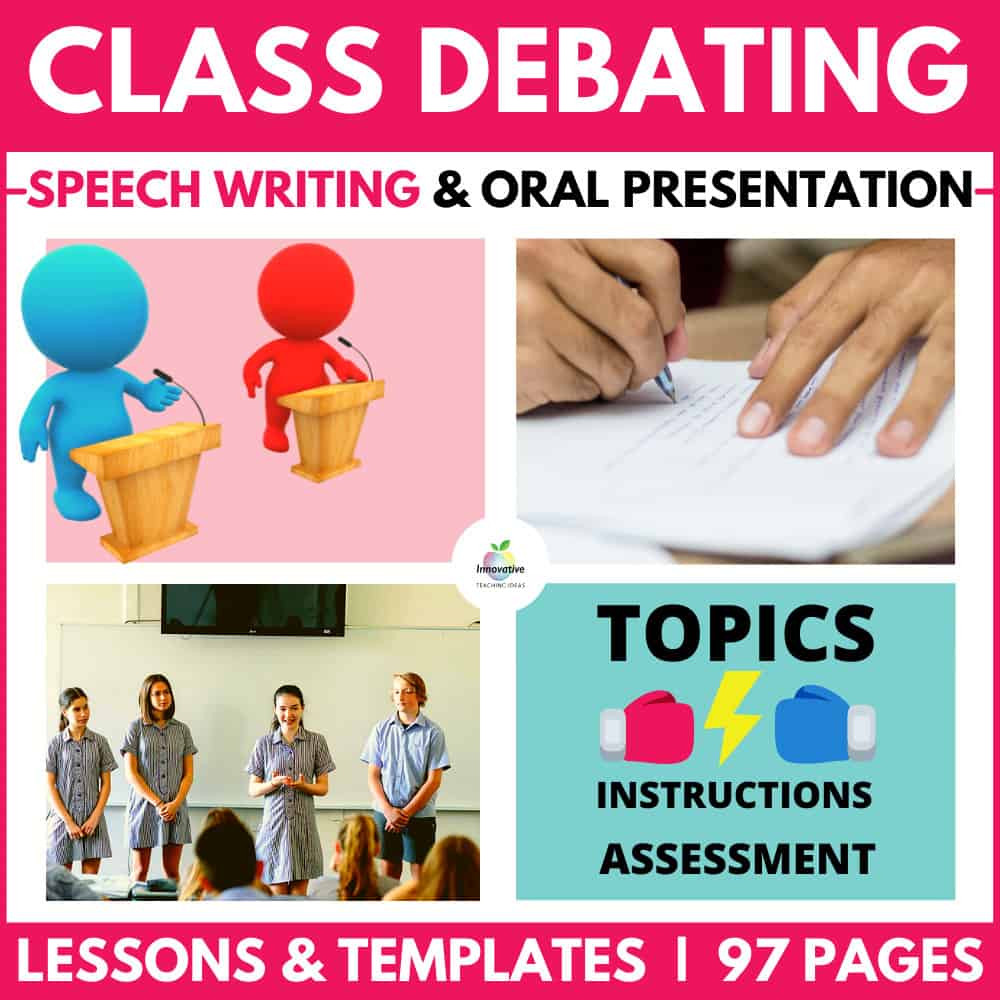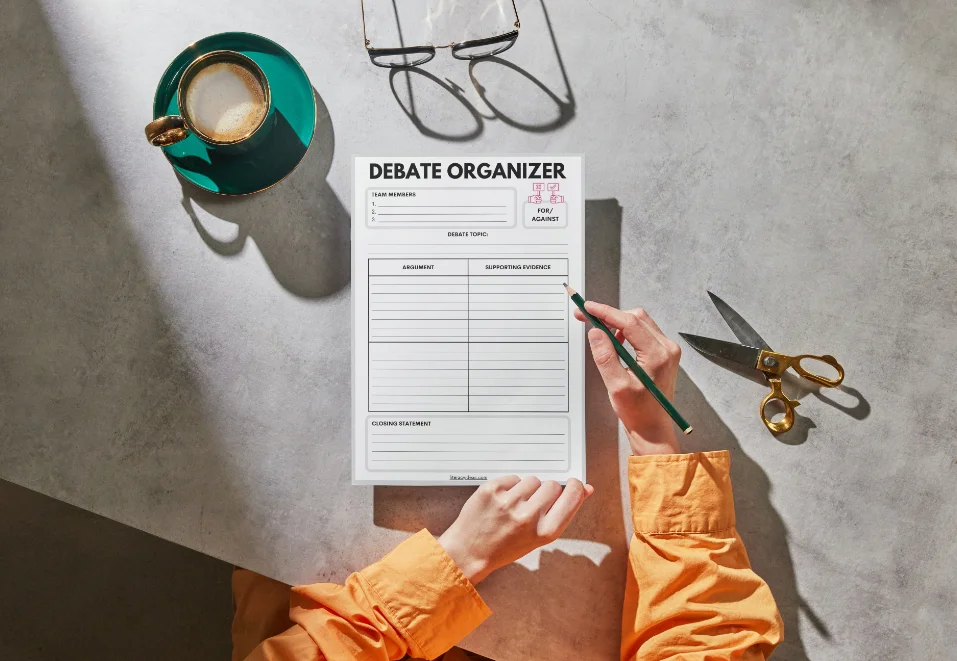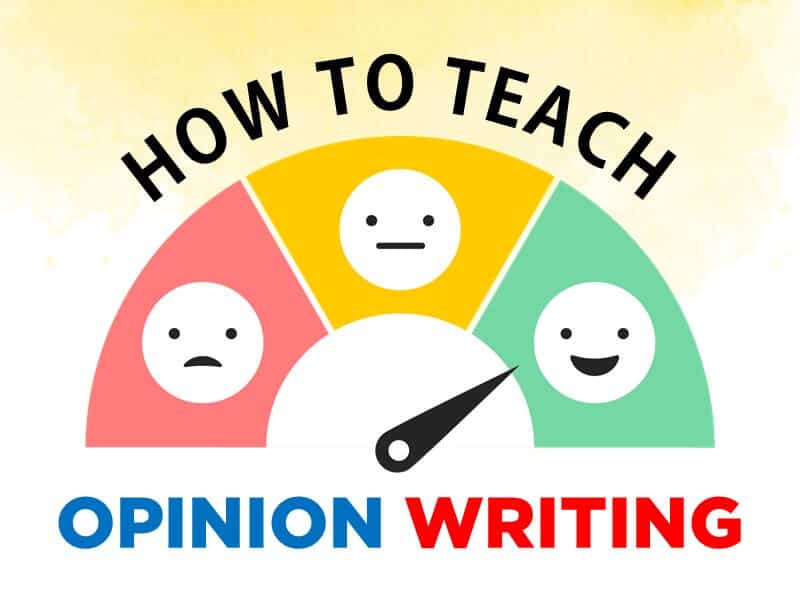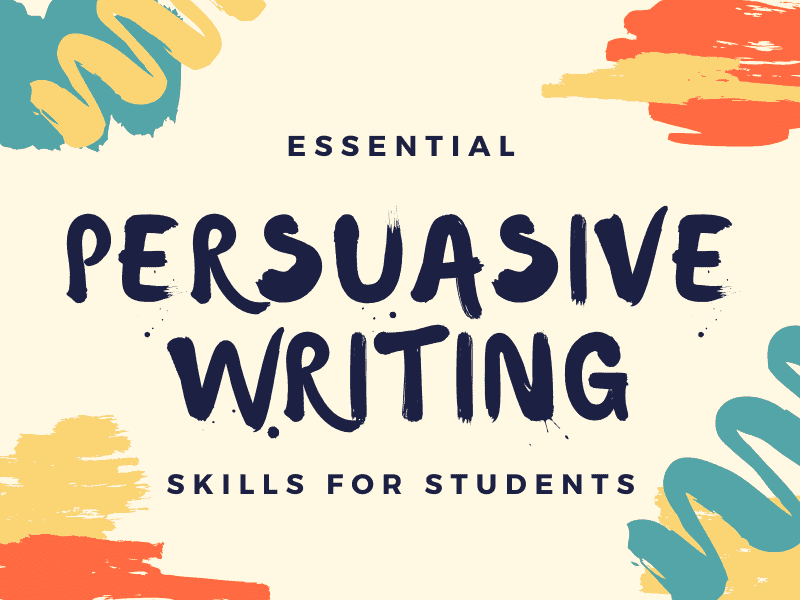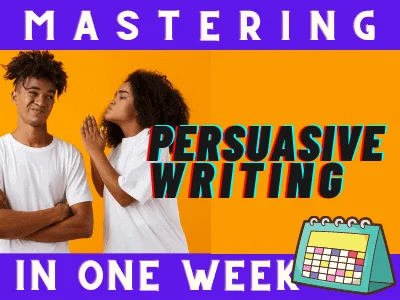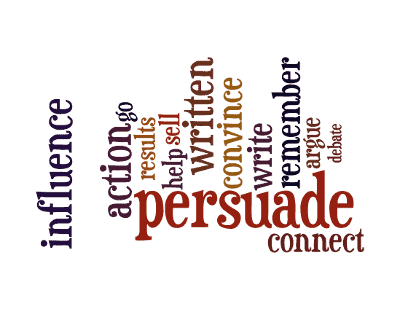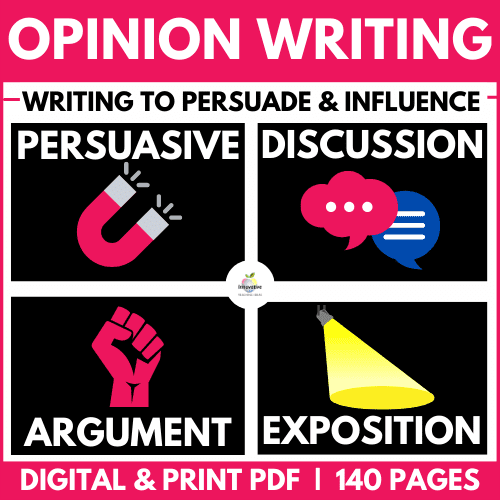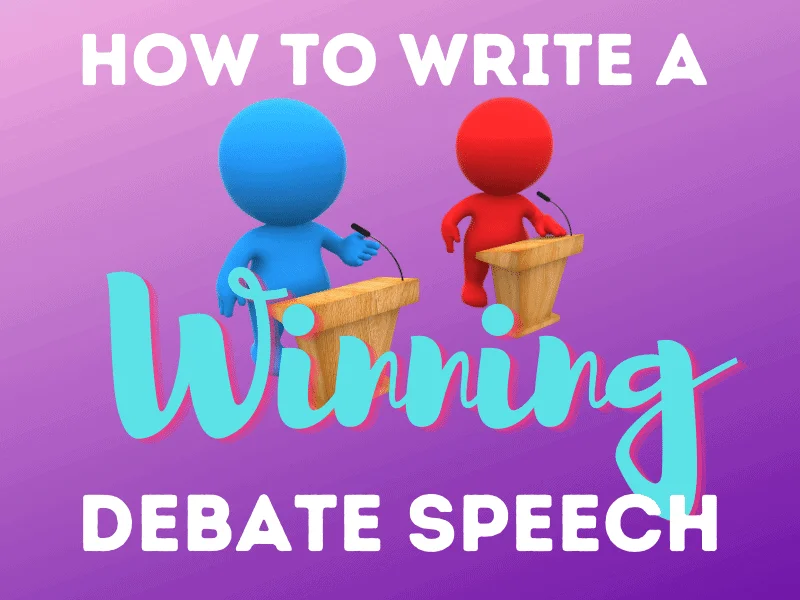
What is a Debate?
A classroom debate involves students delivering persuasive speeches to present and support their opinions on a given subject. This activity helps develop critical thinking and communication skills, enabling students to gain a more comprehensive grasp of various topics.
Debate speeches are written according to a set of rules so a moderator can assess their effectiveness and allow others to question or challenge their statements within a formal debate.
A classroom debate is not an unruly fight or pointless argument but a structured formal conversation on a chosen topic in which two teams argue for or against it to convince the neutral moderator that they hold the stronger position.
Debating is a form of persuasive communication, and while we will be sticking to the fundamentals of how to write a debating speech, we also have a great guide to persuasive essay writing that elaborates on specific persuasive techniques.
Complete Teaching Unit on Class Debating
How To Run A Classroom Debate
Before jumping in headfirst to write your debating speech, ensure you understand how a debate is run to maximise your strategy and impact when it counts.
Debates occur in many different contexts, such as public meetings, election campaigns, legislative assemblies, and as entertainment on television shows. These contexts determine the specific structure the debate will follow.
This guide provides a basic step-by-step debate structure we can comfortably run with students in a classroom. By familiarizing students with this structure, they will effortlessly transition to other debate frameworks.
Running a classroom debate can be an engaging and educational activity that helps students develop critical thinking, communication, and research skills. Here’s a step-by-step guide on how to organize and facilitate a successful classroom debate:
1. Choose a Topic For Your Debate.
Also called a resolution or a motion, the topic is sometimes chosen to debate. This is usually the case in a school activity to practice debating skills.
The resolution or motion is usually centered around a true or false statement or a proposal to change the current situation. Often, the motion starts, ”This House believes that….”
Select a topic relevant to your curriculum and the students’ interests. Ensure that it is debatable and has multiple perspectives. Further down this article, you can find a list of popular classroom debating topics.
2. Form Two Debating Teams
Two teams of three speakers each are formed. These are referred to as ‘The House for the Motion’ or the ‘Affirmative’ team and ‘The House Against the Motion’ or the ‘Negative’ team.
Preparation is an essential aspect of debating. The speech and debate team members will need time to research their arguments, collaborate, and organize themselves and their respective roles in the upcoming debate.
They’ll also need time to write and rehearse their speeches. The better prepared and coordinated they are as a team, the greater their chances of success in the debate.
3. Assign Roles to Students.
Each team member should have a specific role, such as speaker, researcher, or rebuttal specialist. This encourages teamwork and ensures that each student is actively involved.
4. Research and Preparation:
- Allocate time for teams to research and prepare their arguments. Encourage students to use multiple sources, including books, articles, and reputable websites. Make sure you read our complete guide to powerful student research strategies.
5. Set Debate Format:
- Define the debate format, including the structure of each round. Common formats include opening statements, cross-examination, rebuttals, and closing statements.
6. Establish Rules:
- Set ground rules for the debate, such as time limits for each speaker, etiquette, guidelines for respectful communication, and consequences for rule violations.
7. Conduct a Practice Debate:
- Before the actual debate, conduct a practice round. This helps students become familiar with the format and allows you to provide feedback on their arguments and presentation skills.
- On the day of the debate, set up the classroom to accommodate the format. Ensure that each round has a clear structure, and designate a timekeeper to keep the debate on schedule.
9. Facilitate Q&A Sessions:
- After each team presents their arguments, allow time for questions and cross-examination. This encourages critical thinking and engagement among the students.
10. Evaluate and Debrief:
- After the debate, provide constructive feedback to each team. Discuss the strengths and weaknesses of their arguments, presentation skills, and teamwork. Also, please encourage students to reflect on what they learned from the experience.
- Have a class discussion about the debate, exploring different perspectives and opinions. This can deepen students’ understanding of the topic and enhance their critical thinking skills.
Consider integrating the debate topic into future lessons or assignments. This reinforces the learning experience and allows students to delve deeper into the subject matter.
Remember to create a supportive and respectful environment throughout the debate, emphasizing the importance of listening to opposing views and engaging in constructive dialogue.
Each speaker takes a turn making their speech, alternating between the House for the Motion, who goes first, and the House Against the Motion. Each speaker speaks for a pre-agreed amount of time.
Ensure your debate is held in front of an audience (in this case, the class), and occasionally, the audience is given time to ask questions after all the speeches have been made.
Finally, the debate is judged either by moderators or by an audience vote.
How To Write A Debate
How To Start A Debate Speech
In highly competitive speech and debate tournaments, students are only provided the topic on the day, and limited time is allowed for preparation, but this is not recommended for beginners.
Regardless of the stakes of your classroom debate, the speechwriting process always begins with research. Thorough research will provide students with both the arguments and the supporting evidence for their position on a topic and generate forward-thinking about what their opponents might use against them.
Writing Your Introduction
The purpose of the introduction in a debate speech is to achieve several things:
- Grab the attention of the audience,
- Introduce the topic
- Provide a thesis statement
- Preview some of the main arguments.
Grab The Attention Of Your Audience With Strong Hooks
Securing the audience’s attention is crucial, and failure to do this will have a strong, negative impact on how the team’s efforts will be scored as a whole. Let’s explore three proven strategies to hook your audience and align their thinking to yours.
| Hook Type | Details |
|---|---|
| Use a Quotation From a Well-Known Person | Quotes from reputable individuals add credibility and authority to your arguments. They demonstrate that influential figures endorse your viewpoint. They provide a concise and impactful way to convey complex ideas or express a widely accepted perspective. Quotations can resonate with the audience, evoke emotions, and make your speech more memorable. By referencing respected individuals, you tap into their expertise and reputation, supporting your position and increasing the persuasive impact of your debate speech. Using a quotation from a well-known person is a great way to draw eyeballs and ears in the speaker’s direction. People love celebrities, even if that celebrity is relatively minor. Using a quotation to open a speech lends authority to what is being said. In addition, the quotation chosen will usually be worded concisely and interestingly, making it all the more memorable and impactful for the audience. |
| Use Statistics and Data to Support Your Position | Quotes from reputable individuals add credibility and authority to your arguments. They demonstrate that influential figures endorse your viewpoint. They provide a concise and impactful way to convey complex ideas or express a widely accepted perspective. Quotations can resonate with the audience, evoke emotions, and make your speech more memorable. By referencing respected individuals, you tap into their expertise and reputation, lending support to your position and increasing the persuasive impact of your debate speech. Using a quotation from a well-known person is a great way to draw eyeballs and ears in the speaker’s direction. People love celebrities, even if that celebrity is relatively minor. Using a quotation to open a speech lends authority to what is being said. In addition, the quotation chosen will usually be worded concisely and interestingly, making it all the more memorable and impactful for the audience. |
| Use a Personal Anecdote To Warm Up The Audience | An anecdote is a short, personal story that illustrates or emphasizes a point, often used to make a subject more relatable, and they are a valuable way to ease the audience into a complex topic. Your stories can be used to make complicated moral or ethical dilemmas more relatable for an audience. Anecdotes are also an effective way for the speaker to build a rapport with the audience, which, in turn, makes the task of persuading them an easier one. |
Introduce Your Topic With Efficiency and Effectiveness
Once the audience’s attention has been firmly grasped, it’s time to introduce the topic or the motion. This should be done straightforwardly and transparently to ensure the audience understands the topic of the debate and the position you are approaching it from.
For example, if the topic of the debate was school uniforms, the topic may be introduced with:
“Today, we will debate whether school uniforms should be compulsory for all high school students.”
Provide Your Thesis Statement
A thesis statement is a concise declaration summarizing the points and arguments of your debating speech.
- It presents a clear stance on a topic and guides the reader on what to expect in the content.
- A good thesis statement is debatable and allows for opposing viewpoints and discussion.
- It serves as a roadmap for the writer, ensuring coherence and focus in the piece.
- It helps the audience understand the purpose and direction of the work from the beginning.
The thesis statement should express the student’s or the team’s position on the motion. Clearly explaining the speaker’s side of the debate. An example can be seen here.
“Today, we will debate whether school uniforms should be compulsory for all high school students. This house believes (or, I believe…) that school uniforms should not be compulsory for high school students.”
Provide A Preview Of Your Arguments
The final part of the introduction section of a debate speech involves previewing the main points of the speech for the audience.
There is no need to go into detail with each argument here; that’s what the body of the speech is for. It is enough to provide a general thesis statement for each argument or ‘claims’ – (more on this to follow).
Previewing the arguments in a speech is especially important as the audience and judges only get one listen to a speech – unlike a text, which can be reread as frequently as the reader likes.
debate introduction examples for students
"Ladies and gentlemen, esteemed judges, and fellow students, imagine a world where access to education is not a privilege but a fundamental right. Today, I stand before you to affirm that education should be free for all. It is time we break down the barriers that limit opportunities and build a society where knowledge is not determined by one's financial circumstances." "Good morning, respected panel of judges and fellow classmates. The topic at hand demands our attention and action: should genetically modified organisms (GMOs) be embraced or rejected? As I step forward, I firmly believe that GMOs hold the potential to revolutionize agriculture, alleviate world hunger, and shape a sustainable future. Let us delve into the complexities of this issue and explore why embracing GMOs is a crucial step towards a better world." "Honorable adjudicators, distinguished guests, and fellow debaters, today we confront the controversial question of whether social media is a blessing or a curse. In an era defined by virtual connections, viral trends, and endless scrolling, it is imperative to recognize the tremendous impact social media wields. As I take the affirmative stance, I assert that social media, when used responsibly, empowers individuals, amplifies voices, and paves the way for positive societal change. Join me in this exploration of the transformative power of our digital age."
Attention Grabbers Task
After explaining the different types of attention grabbers and the format for the rest of the introduction to your students, challenge them to write an example of each type of opening for a specific debate topic.
When they’ve finished writing these speech openings, discuss with the students which one best fits their chosen topic. Then, they can continue by completing the rest of the introduction for their speech using the format described above.
You might like to try a simple topic like “Homework should be banned.” you can choose from our collection further in this article.
Writing The Body of the Speech
The body paragraphs are the real meat of the speech. They contain the in-depth arguments that make up the substance of the debate, and How well these arguments are made will determine how the judges will assess each speaker’s performance, so it’s essential to get the structure of these arguments just right.
Let’s take a look at how to do that.
How to structure an Argument
With the introduction out of the way, it’s time for the student to get down to the nitty-gritty of the debate – that is, making compelling arguments to support their case.
There are three main aspects to an argument in a debate speech. They are:
- The Claim
- The Warrant
- The Impact
| The Claim | The first part of an argument, The claim is the assertion that the argument is attempting to prove. It’s the starting point and sets the direction for your whole argument, so it’s super important to make it clear and convincing. |
| The Warrant | Think of the warrant as the support system for your claim. It’s like the proof or reasoning that backs up what you’re saying. It’s the part that explains why your evidence actually supports your main point, making your argument strong and convincing. |
| The Impact | Finally, The impact in an argument highlights why the claim is important, going beyond proving the point. It explores the broader implications, helping draw meaningful conclusions from the established truth of the assertion. |
Following this structure carefully enables our students to build coherent and robust arguments. Ttake a look at these elements in action in the example below.
(Claim) Climate change is a pressing global issue that demands urgent attention. (Warrant) Rising global temperatures, increasing frequency of extreme weather events, and scientific consensus all provide compelling evidence of human-induced climate change. The overwhelming majority of climate scientists agree that human activities, such as burning fossil fuels, contribute significantly to the observed changes in our climate. (Impact) Addressing climate change is not merely an environmental concern; it directly impacts our economies, health, and overall well-being. Without decisive action, we risk catastrophic consequences, including more frequent and severe natural disasters, disruptions to food and water supplies, and adverse effects on human health. Tackling climate change is an ethical imperative, ensuring a sustainable future for generations to come.
Brainstorming Arguments
Present your students with a topic and, as a class, brainstorm some arguments for and against the motion.
Then, ask students to choose one argument and, using the Claim-Warrant-Impact format, take a few moments to write down a well-structured argument that’s up to debate standard.
Students can then present their arguments to the class.
Or, you could also divide the class along pro/con lines and host a mini-debate!
Concluding a Debate Speech
The conclusion of a speech or a debate is the final chance for the speaker to convey their message to the audience. In a formal debate that has a set time limit, the conclusion is crucial as it demonstrates the speaker’s ability to cover all their material within the given time frame.
Avoid introducing new information and focus on reinforcing the strength of your position for a compelling and memorable conclusion.
A good conclusion should refer back to the introduction and restate the main position of the speaker, followed by a summary of the key arguments presented. Finally, the speaker should end the speech with a powerful image that will leave a lasting impression on the audience and judges.

Examples of strong debate Conclusions
"In conclusion, let us remember that education is the cornerstone of progress and equality. By advocating for free access to education, we can empower individuals, uplift communities, and create a society that thrives on knowledge and opportunity. Together, let us dismantle the barriers that hinder educational attainment and pave the way for a brighter future for all." "As I conclude, it is clear that embracing genetically modified organisms holds immense potential for addressing global food security and environmental sustainability. By utilizing the advancements of biotechnology, we can cultivate crops that are more resistant to pests, droughts, and diseases, ultimately leading to increased yields and a more resilient agricultural system. Let us seize this opportunity to embrace scientific progress and work towards a world where no one goes hungry." "In closing, social media is a double-edged sword that demands our conscious engagement. While it can foster connections, facilitate communication, and drive social change, we must also navigate its pitfalls and guard against its negative impacts. By promoting digital literacy, responsible usage, and mindful engagement, we can harness the transformative power of social media and shape a digital landscape that is inclusive, authentic, and conducive to the well-being of individuals and communities."
The Burden of the Rejoinder
In formal debates, the burden of the rejoinder means that any time an opponent makes a point for their side, it’s incumbent upon the student/team to address that point directly.
Failing to do so will automatically be seen as accepting the truth of the point made by the opponent.
For example, if the opposing side argues that all grass is pink, despite how ridiculous that statement is, failing to refute that point directly means that, for the debate, all grass is pink.
Our students must understand the burden of the rejoinder and ensure that any points the opposing team makes are fully addressed during the debate.
The Devils Advocate
When preparing to write their speech, students should spend a significant proportion of their team collaborating as a team.
One good way to practice the burden of the rejoinder concept is to use the concept of Devil’s Advocate, whereby one team member acts as a member of the opposing team, posing arguments from the other side for the speaker to counter, sharpening up their refutation skills in the process.
20 Great Debating Topics for Students
- Should cell phones be allowed in schools?
- Is climate change primarily caused by human activities?
- Should the voting age be lowered to 16?
- Is social media more harmful than beneficial to society?
- Should genetically modified organisms (GMOs) be embraced or rejected?
- Is the death penalty an effective crime deterrent?
- Should schools implement mandatory drug testing for students?
- Is animal testing necessary for scientific and medical advancements?
- Should school uniforms be mandatory?
- Is censorship justified in certain circumstances?
- Should the use of performance-enhancing drugs be allowed in sports?
- Is homeschooling more beneficial than traditional schooling?
- Should the use of plastic bags be banned?
- Is nuclear energy a viable solution to the world’s energy needs?
- Should the government regulate the fast food industry?
- Is social inequality a result of systemic factors or individual choices?
- Should the consumption of meat be reduced for environmental reasons?
- Is online learning more effective than traditional classroom learning?
- Should the use of drones in warfare be banned?
- Is the legalization of marijuana beneficial for society?
These topics cover a range of subjects and offer students the opportunity to engage in thought-provoking debates on relevant and impactful issues.
OTHER GREAT ARTICLES RELATED TO DEBATING
Debating Strategies For Students
Research and preparation are essential to ensure good performance in a debate. Students should spend as much time as possible drafting and redrafting their speeches to maximize their chances of winning. However, a debate is a dynamic activity, and victory cannot be assured by pre-writing alone.
Students must understand that the key to securing victory lies in also being able to think, write (often in the form of notes), and respond instantly amid the turmoil of the verbal battle. To do this, students must understand the following keys to victory.
Listen!
When we think of winning a debate, we often think of blinding the enemy with the brilliance of our verbal eloquence. We think of impressing the audience and the judges alike with our outstanding oratory.
What we don’t often picture when we imagine what a debate winner looks like is a quiet figure sitting and listening intently. But being a good listener is one of our students’ most critical debating skills.
If students don’t listen to the other side, whether by researching opposing arguments or during the thrust of the actual debate, they won’t know the arguments the other side is making. Without this knowledge, they cannot effectively refute the opposition’s claims.
Read the Audience
In terms of the writing that happens before the debate takes place, this means knowing your audience.
Students should learn that how they present their arguments may change according to the demographics of the audience and/or judges to whom they will be making their speech.
An audience of retired school teachers and an audience of teen students may have very different responses to the same arguments.
This applies during the actual debate itself too. If the student making their speech reads resistance in the faces of the listeners, they should be prepared to adapt their approach accordingly in mid-speech.
Practice, Practice, Practice
The student must practice their speech before the debate. There’s no need to learn it entirely by heart. There isn’t usually an expectation to memorize a speech entirely, and doing so can lead to the speaker losing some of their spontaneity and power in their delivery. At the same time, students shouldn’t spend the whole speech bent over a sheet of paper reading word by word.
Ideally, students should familiarize themselves with the content and be prepared to deliver their speech using flashcards as prompts when necessary.
Another important element for students to focus on when practising their speech is making their body language, facial expressions, and hand gestures coherent with the verbal content of their speech. One excellent way to achieve this is for the student to practice delivering their speech in a mirror.
And Finally…
Debating is a lot of fun to teach and partake in, but it also offers students a valuable opportunity to pick up some powerful life skills.
It helps students develop a knack for distinguishing fact from opinion and an ability to assess whether a source is credible or not. It also helps to encourage them to think about the other side of the argument.
Debating helps our students understand others, even when disagreeing with them. An important skill in these challenging times, without a doubt.
Debating Teaching Strategies
Clearly Define Debate Roles and Structure when running speech and debate events: Clearly define the roles of speakers, timekeepers, moderators, and audience members. Establish a structured format with specific time limits for speeches, rebuttals, and audience participation. This ensures a well-organized and engaging debate.
- Provide Topic Selection and Preparation Time: Offer students a range of debate topics, allowing them to select a subject they are passionate about. Allocate ample time for research and preparation, encouraging students to gather evidence, develop strong arguments, and anticipate counterarguments.
- Incorporate Scaffolded Debating Skills Practice: Before the actual debate, engage students in scaffolded activities that build their debating skills. This can include small group discussions, mock debates, or persuasive writing exercises. Provide feedback and guidance to help students refine their arguments and delivery.
- Encourage Active Listening and Note-taking during speech and debate competitions: Emphasize the importance of active listening during the debate. Encourage students to take notes on key points, supporting evidence, and persuasive techniques used by speakers. This cultivates critical thinking skills and prepares them for thoughtful responses during rebuttals.
- Facilitate Post-Debate Reflection and Discussion: After the debate, facilitate a reflection session where students can share their thoughts, lessons learned, and insights gained. Encourage them to analyze the strengths and weaknesses of their arguments and engage in constructive dialogue. This promotes metacognitive skills and encourages continuous improvement.
By following these tips, teachers can create a vibrant and educational debate experience for their students. Through structured preparation, active engagement, and reflective discussions, students develop valuable literacy and critical thinking skills that extend beyond the boundaries of the debate itself.


